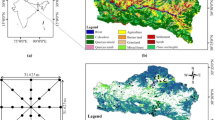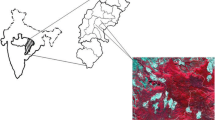Abstract
Spectral modeling of above ground biomass (AGB) with field data collected in 48 field sites representing moist deciduous forest in Surat district is reported. Models were generated using LISS-III and MODIS data. The plot-wise field data was aggregated to MODIS pixel (250 m) using area weightages of forest/vegetation. The study reports that above ground phytomass varied from 6.13 t/ha to 389.166 t/ha while AGB phytomass estimated using area-weights for sites of 250×250 m, ranged from 5.534 t/ha to 134.082 t/ha. The contribution of bamboo in AGB has been found very high. The analysis indicated that the highest correlation between AGB phytomass and red band (R) of MODIS satellite data of October was (R2=0.7823) and R2=0.6998 with both NDVI of October data as well as NDVImax. High correlation (R2=0.402) with IR band of February month was also found. The phytomass range obtained by using MODIS data varies from 0.147 t/ha to 182.16 t/ha. The mean biomass is 40.50 t/ha. Total biomass is 31.44 Mt. The mean Carbon density is 19.44 tC/ha in forest areas. The study is validation of region-wise spectral modeling approach that will be adopted for mapping vegetation carbon pool of the India under National Carbon Project of ISRO-Geosphere Biosphere Programme.








Similar content being viewed by others
References
Brown, S., Gillespie, A. J. R., & Lugo, A. E. (1991). Phytomass of tropical forests of south and Southeast Asia. Canadian Journal of Forest Research, 21, 111–117.
Chaturvedi, O. P., & Singh, J. S. (1987). The structure and function of Pine forest in Central Himalaya. I. Dry matter dynamics. Annals of Botany 60, 237–252.
Chhabra, A., & Dadhwal, V. K. (2004). Assessment of major pools and fluxes of carbon in Indian forests. Climate Change, 64, 341–360.
Dadhwal, V. K., & Chhabra, A. (2000). Carbon cycle assessment for terrestrial biosphere of India. In R. Narasimha, I. P. Abrol, G. Joseph, S. W. A. Naqvi, D. C. Parashar, & P. B. Rao (Eds.), IGBP in India 2000: A status report on projects (pp. 358–370). New Delhi: Indian National Science Academy.
Dadhwal, V. K., & Shah, A. (1997). Recent changes in forest phytomass carbon pool in India estimated using growing stock and remote sensing-based forest inventories. Journal of Tropical Forestry 13, 182–188.
Dadhwal, V. K., Pandya, N., & Vora, A. B. (1998). Carbon cycle for Indian forest ecosystem: a preliminary estimate. In: Subbaraya B.H., Rao D.P., Desai P.S., Manikiam, Rajaratnam P. (Eds.). Global change studies: scienti6c results from ISRO-GBP, ISRO Bangalore, pp. 411–430.
FAO (1990). Forest resource assessment. FAO Forestry Paper-112, Food and Agricultural Organization of the United Nations Rome.
Flint, E. P., & Richards, J. F. (1991). Historical analysis of changes in use and carbon stock of vegetation in South and Southeast Asia. Canadian Journal Forest Research, 21(1), 91–110.
Foody, G. M., Boyd, D. S., & Cutler, M. E. J. (2003). Predictive relations of tropical forest phytomass from Landsat TM data and their transferability between regions. Remote Sensing of Environment, 85, 463–474.
FRI. (1996). Volume equations for forester of INDIA, NEPAL and BHUTAN (pp. 1–249). Dehradun: Ministry of Environment and Forests, Government of India.
FSI (2003). State of forest report. 2003. Forest Survey of India, Ministry of Environment and Forests, Dehradun
Haripriya, G. S. (2002). Phytomass carbon of truncated diameter in Indian forests. Forest Ecology and Management, 168, 1–13.
Hingane, L. S. (1991). Some aspects of Carbon dioxide exchange between atmosphere and Indian plant biota. Climate Change 18, 425–35.
Houghton, R. A. (1991). Tropical deforestation and atmospheric carbon dioxide. Climate Change, 19, 99–118.
ICFRE (1996–2002). Indian woods their identification, properties and uses. Volumes I-VI, Revised Edition. Indian Council of Forestry Research & Education, Dehradun
IPCC. (2003). Good practice guidance for land use, land use change and forestry. (p. 295). Hayama, Japan: IPCC National Greenhouse Gas Inventories Programe.
Kale, M. P., Singh, S., & Roy, P. S. (2002). Biomass and productivity estimation using aerospace data and geographic Information System. Tropical Ecology, 43(1), 123–136. fig. 1–8.
Kale, M., Singh, S., Roy, P. S., Deosthali, V., & Ghole, V. S. (2004). Biomass equations of dominant species of dry deciduous forest in Shivpuri district, Madhya Pradesh. Current Science, 87(5), 683–687. figs. 4.
Kira, T., & Ogava, H. (1971). Assessment of primary production in tropical forests. Proceedings of Productivity of Forest Ecosystems, Brussels-1969, UNESCO Publication.
Lodhiyal, N., & Lodhiyal, L. S. (2002). Phytomass and net primary productivity of Bhabar Shisham forests in central Himalaya, India. Forest Ecology and Management, 176, 217–235.
Lu, D. (2005). Aboveground phytomass estimation using Landsat TM data in the Brazilian Amazon. International Journal of Remote Sensing, 26(12), 2509–2525.
Muukkonen, P., & Heiskanen, J. (2007). Phytomass estimation over a large area based on standwise forest inventory data and ASTER and MODIS satellite data: a possibility to verify carbon inventories. Remote Sensing of Environment, 107, 617–624.
Ovington, J. D. (1968). Some factors affecting nutrient distribution within ecosystems. In: F.E. Eckardt (Ed.). Functioning of Terrestrial Ecosystems of the Primary Production Level Proc. Copen. Symp., UNESCO, Paris, pp. 95–105.
Pande, P. K. (2005). Biomass and Productivity in some disturbed tropical dry deciduous teak forests of Satpura Plateau, Madhya Pradesh. Tropical Ecology 46(2), 229–239.
Ranawat, M. P. S., & Vyas, L. N. (1975). Litter production in deciduous forests of Koriyat, Udaipur (South Rajasthan) India. Biologia, 30, 41–47.
Ravindranath, N. H., Somashekhar, B. S., & Gadgil, M. (1995). Carbon flow in Indian forests. Carbon emissions and sequestration in forests: Case studies from India and China. Lawrence Berkley Laboratory, CA, USA.
Rawat, L., Luna, R. K., Kholiya, D., & Kamboj, S. K. (2008). Biomass, productivity and nutrient retention in Acacia Catechu Willd. Plantations in Shiwalik Hills. Indian Forester, 134(2), 212–225.
Rawat, Y. S., & Singh, J. S. (1988). Structure and function of Oak forests in central Himalaya. I. dry matter dynamics. Annals of Botany 62, 397–411.
Roy, P. S., & Ravan, S. A. (1996). Biomass estimation using satellite remote sensing data—an investigation on possible approaches for natural forest. Journal of Biosciences, 21(4), 535–561.
Sader, S. A., Waide, R. B., Lawrence, W. T., & Joyce, A. T. (1989). Tropical forest phytomass and successional age class relationships to a vegetation index derived from Landsat TM data. Remote Sensing of Environment, 28, 143–156.
Tiwari, A. K. (1992). Component-wise biomass models for trees. A non-harvest technique. Indian For., 118, 405–410.
Tiwari, A. K. (1994). Mapping forest phytomass through digital processing of IRS-1A data. International Journal of Remote Sensing, 15(9), 1849–1866.
Vasishth, A. M., JR, C. P. S., & Pandey, S. B. S. (2008). Bamboo—a vital resource for prudent utilization. Indian Forester, 134(3), 345–348.
Whittaker, R. H. (1966). Forest dimensions and production in the Great Smoky Mountains. Ecology 47(1), 103–121.
Acknowledgement
The study is a part of National Carbon Project funded by Indian Space research Organization, Government of India under its ISRO-Geosphere Biosphere Programme. The support and encouragement from Programme Director, IGBP are duly acknowledged. Authors would like thank Director, National Remote Sensing Centre, Hyderabad for providing facilities and encouragements. We also wish to acknowledge the help and logistic support received from Gujarat Forest Department at Surat during the field survey.
Author information
Authors and Affiliations
Corresponding author
About this article
Cite this article
Patil, P., Singh, S. & Dadhwal, V.K. Above Ground Forest Phytomass Assessment in Southern Gujarat. J Indian Soc Remote Sens 40, 37–46 (2012). https://doi.org/10.1007/s12524-011-0121-3
Received:
Accepted:
Published:
Issue Date:
DOI: https://doi.org/10.1007/s12524-011-0121-3




